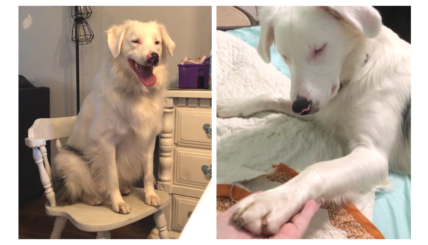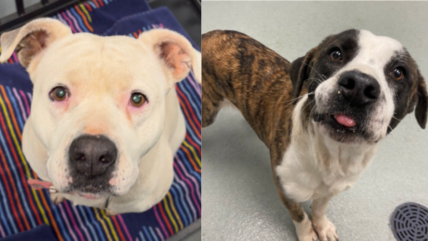The Devastating Effects of Inbreeding of Dogs—And Why It’s Worse Than You Think
Purebred dogs may look picture-perfect, but behind those tightly controlled bloodlines lies a harsh reality: inbreeding of dogs has serious consequences. For centuries, breeders have used selective inbreeding to enhance desirable traits—coat color, size, muzzle shape—but at a cost. When dogs are bred from a limited gene pool, genetic diseases and disabilities skyrocket, leaving generations of dogs to suffer.
But inbreeding isn’t just a problem in the world of show dogs. It happens in backyard breeding, hoarding cases, and irresponsible pairings, where dogs are bred without any concern for their health.. Just ask Aristaeus (Ari), a blind and deaf Pit Bull-Lab mix who was rescued from a hoarding case riddled with unchecked inbreeding. Ari’s story isn’t unique—he’s just one of many dogs born into a cycle of genetic misfortune.

What Is Inbreeding of Dogs, and Why Is It So Risky?
At its core, inbreeding is the mating of closely related dogs. The closer the relation, the higher the risk of inherited disorders. While some genetic conditions (like hip dysplasia) are well known, others lurk beneath the surface, only appearing when two recessive genes match up.
“Offspring from a mother-son mating would have a 25% chance of inheriting two bad copies of rare genetic mutations,” explains Dr. Adam Boyko, PhD, co-founder of Embark Veterinary, Inc. “This is a greater than 100-fold risk compared to an outbred dog!”
In simpler terms? Dogs from inbred pairings are genetic time bombs.
The Ugly Side Effects of Dog Inbreeding

Inbred dogs don’t just face health problems—they also struggle with temperament and behavior. Rocky Kanaka, pet rescue advocate, has seen the impact firsthand. “I’ve worked with so many inbred rescues, and the reality is heartbreaking,” he says. “These dogs can have severe anxiety, neurological issues, and sometimes aggression—not because they’re bad dogs, but because they were born with the deck stacked against them.”
Here are just a few common issues inbred dogs face:
🔴 Deafness & Blindness – Like Ari, many inbred dogs are born without functioning ears or eyes.
🔴 Weakened Immune Systems – Prone to infections, slow healing, and chronic illness.
🔴 Severe Joint & Bone Problems – Hip dysplasia, bowed legs, and mobility issues.
🔴 Respiratory Distress – Brachycephalic breeds (like Bulldogs and Pugs) suffer the most.
🔴 Reactivity & OCD-Like Behaviors – Anxiety, aggression, or compulsive spinning and pacing.
A Redditor in r/dogs put it bluntly: “My purebred Doberman has cardiomyopathy. Cost me $5K in vet bills just to learn she won’t live past 7. Never again.”
The Tragic Cost of Breeding for Profit: The Double Merle Disaster

One of the most devastating examples of reckless inbreeding is the intentional breeding of double merle dogs—a practice driven by profit, not ethics. The merle coat pattern, a striking mix of light and dark patches, is highly desirable, often increasing a dog’s price tag. But when two merle-coated dogs are bred together, one in four puppies (25%) is born as a “double merle,” which significantly increases the risk of blindness, deafness, or both.
Many unethical breeders continue this practice because merle-coated puppies sell for top dollar. “It’s all about the look,” says pet rescue advocate Rocky Kanaka. “People see these beautiful, unique dogs and don’t realize that behind those bright blue eyes is a genetic nightmare. Double merles are often born without functioning eyes or ears—some even lack fully developed eyes altogether.”
Genetic testing is the only way to responsibly breed merle dogs without condemning puppies to a lifetime of suffering. Ethical breeders test their dogs before breeding to ensure they aren’t pairing two merle carriers. But in puppy mills, backyard breeding operations, and hoarding situations, genetic health takes a backseat to fast cash, leaving families unknowingly adopting dogs with severe disabilities.
This reckless breeding isn’t just irresponsible—it’s cruel. Without intervention, blind and deaf double merle dogs often end up dumped in shelters or euthanized because they require special care. But these dogs can live happy lives with the right families—if only breeders would stop playing genetic roulette for profit.
How Responsible Breeders Prevent Inbreeding of Dogs

Ethical breeders test for genetic diversity before choosing breeding pairs. One key measure is the coefficient of inbreeding (COI)—a number that reflects how closely related two dogs are. The lower the COI, the better the genetic health.
Breeds with tiny gene pools (like Cavalier King Charles Spaniels and English Bulldogs) are at especially high risk. Some Bulldogs today are so inbred they can’t even reproduce naturally!
Why It Matters—Even If You’re Not Buying a Purebred
Think this only applies to expensive show dogs? Think again. Backyard breeding and hoarding cases (like Ari’s) also produce dangerously inbred dogs. Without intervention, these dogs are left to suffer with lifelong health problems and shortened lifespans.
The takeaway? Choose a responsible breeder who provides genetic health testing or even better, adopt from your local shelter. Behind every cute puppy photo, there’s a genetic history that can mean the difference between a long, happy life—or years of suffering.






